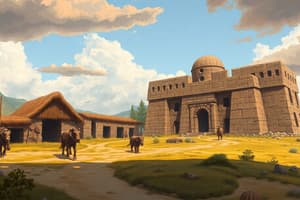Podcast
Questions and Answers
The Prehistoric period lasted from ______ to 3KYA.
The Prehistoric period lasted from ______ to 3KYA.
250KYA
The Stone Age spans from ______ to 5KYA.
The Stone Age spans from ______ to 5KYA.
250KYA
The Paleolithic Age lasted from ______ to 12KYA.
The Paleolithic Age lasted from ______ to 12KYA.
250KYA
During the last ice age, many large mammals went extinct and there was near extinction of ______.
During the last ice age, many large mammals went extinct and there was near extinction of ______.
The early humans who inhabited the Americas are known as the ______ peoples.
The early humans who inhabited the Americas are known as the ______ peoples.
The first archaeological evidence of Clovis peoples was found near ______, New Mexico.
The first archaeological evidence of Clovis peoples was found near ______, New Mexico.
The Clovis First Theory suggests that humans migrated across the Bering ______.
The Clovis First Theory suggests that humans migrated across the Bering ______.
Pre-Clovis remains dating about 19KYA were found in ______ Pennsylvania.
Pre-Clovis remains dating about 19KYA were found in ______ Pennsylvania.
Evidence suggests that Homo Sapiens migrated from ______ to Australia around 40KYA.
Evidence suggests that Homo Sapiens migrated from ______ to Australia around 40KYA.
The land bridge that formed during the ice age is known as ______.
The land bridge that formed during the ice age is known as ______.
Flashcards are hidden until you start studying
Study Notes
Prehistoric Period Overview
- Spanning from 250,000 years ago (KYA) to 3,000 years ago (YA), marked as the unrecorded stage of human history.
- Divided into three main ages:
- Stone Age (250 KYA to 5 KYA)
- Bronze Age (5 KYA to 3,300 YA)
- Iron Age (3,300 YA to 2,900 YA)
Stone Age Subdivisions
- Stone Age further categorized into:
- Paleolithic Age (250 KYA to 12 KYA)
- Mesolithic Age (12 KYA to 10 KYA)
- Neolithic Age (10 KYA to 5 KYA)
Paleolithic Age Significance
- Coincided with Earth’s last ice age, leading to mass extinction of many species and near extinction of Homo Sapiens.
- Provided migration opportunities via land bridges while large ice sheets restricted access to certain regions.
- Marked by significant human migration from Eurasia to the Americas towards its end.
Clovis Peoples
- Early inhabitants of the Americas recognized for unique spear points and stone tools discovered near Clovis, New Mexico.
- First archaeological evidence linked to their existence was uncovered in the 1920s.
Migration Theories
-
Clovis First Theory
- Proposes migration across Bering Strait from Siberia to Alaska around 13 KYA via a land bridge known as Beringia.
- Migrants moved south through new openings in the ice sheets covering Canada, reaching as far as New Mexico.
-
Pre-Clovis Evidence
- Archaeological finds pre-dating Clovis discovery:
- Meadowcroft, Pennsylvania (19 KYA)
- Pedro Furada, Brazil (30 KYA)
- Monteverde, Chile (30 KYA)
- These finds suggest earlier migrations that could not have occurred by land route due to ice sheet geography.
- Archaeological finds pre-dating Clovis discovery:
-
Coastal Route Theory
- Suggests that Pre-Clovis peoples may have migrated by boat from Siberia along the Pacific and Atlantic coasts around 20 KYA using canoes.
-
Solutrean Hypothesis
- Proposes that between 21 KYA, people from the Solutré region of France navigated to North America via pack ice in the Atlantic.
- Notable for similarities in tool designs between Solutrean and North American archaeological sites.
Conclusion on Migration Theories
- Theories regarding Clovis and Pre-Clovis migrations may not be mutually exclusive; a combination of these methods could have facilitated human migration into the Americas.
Studying That Suits You
Use AI to generate personalized quizzes and flashcards to suit your learning preferences.




